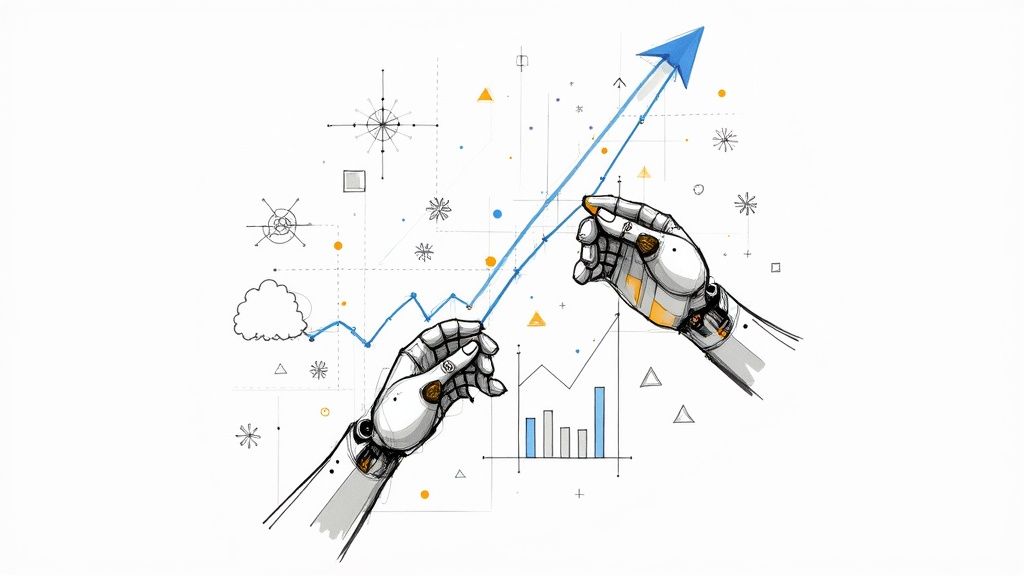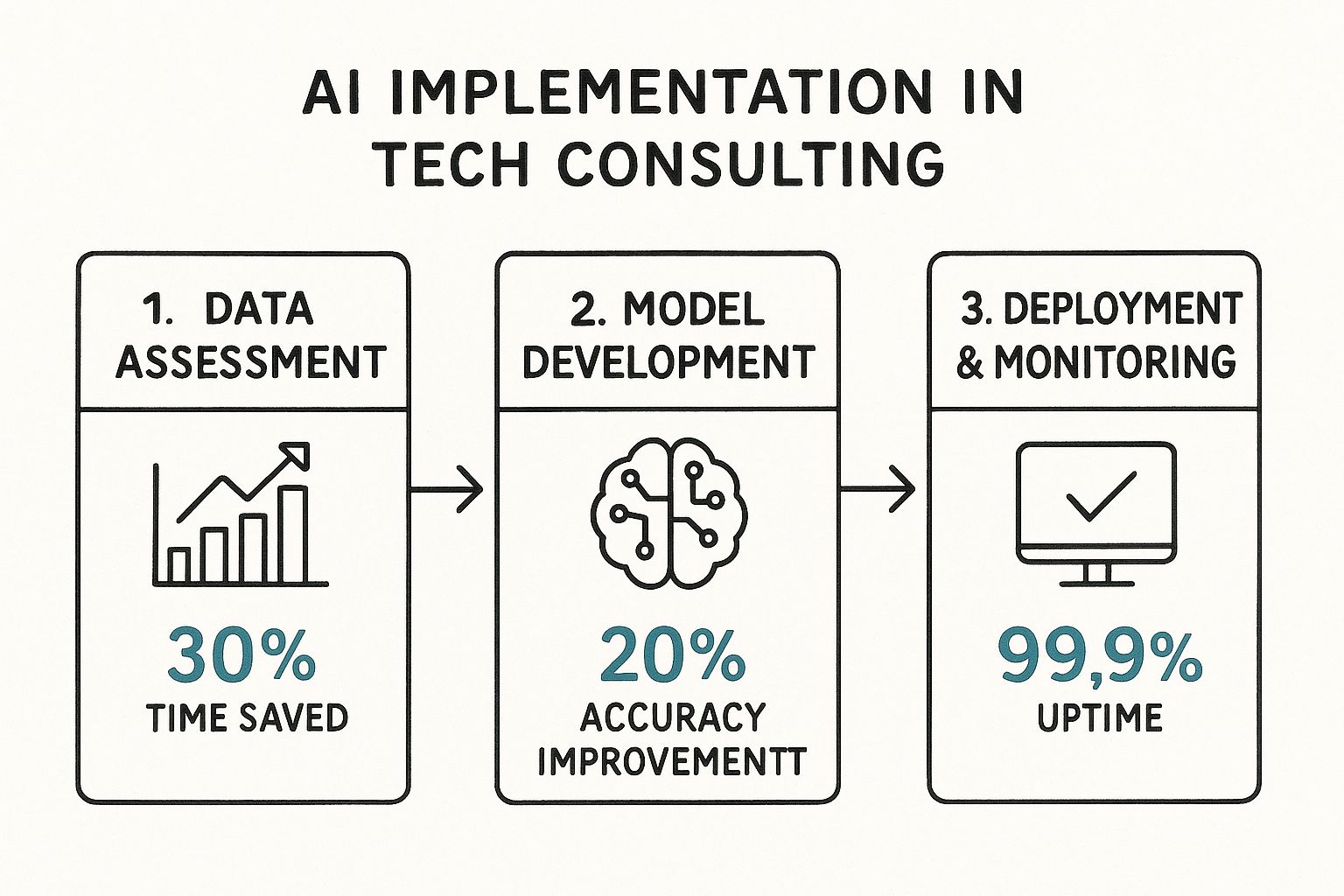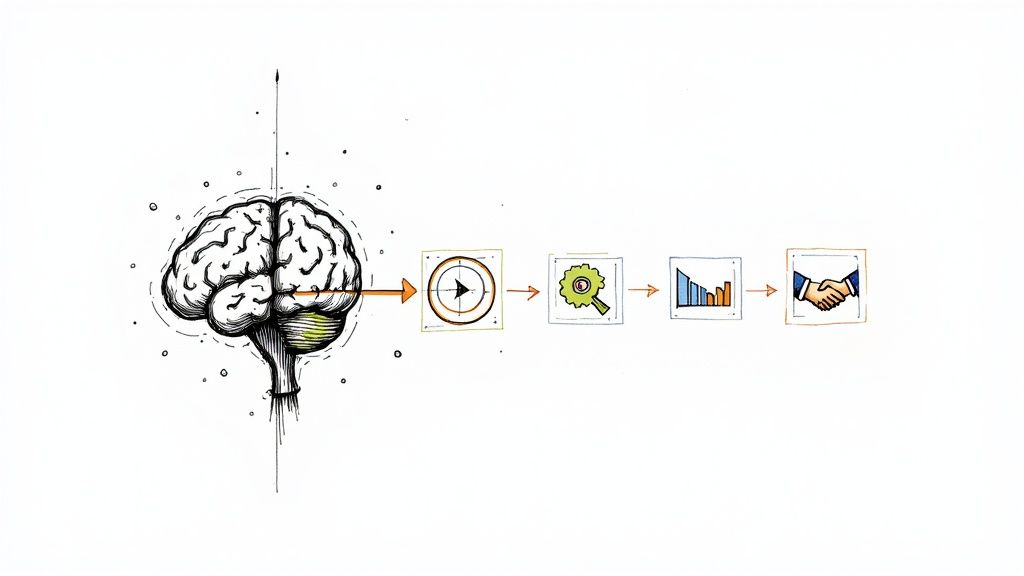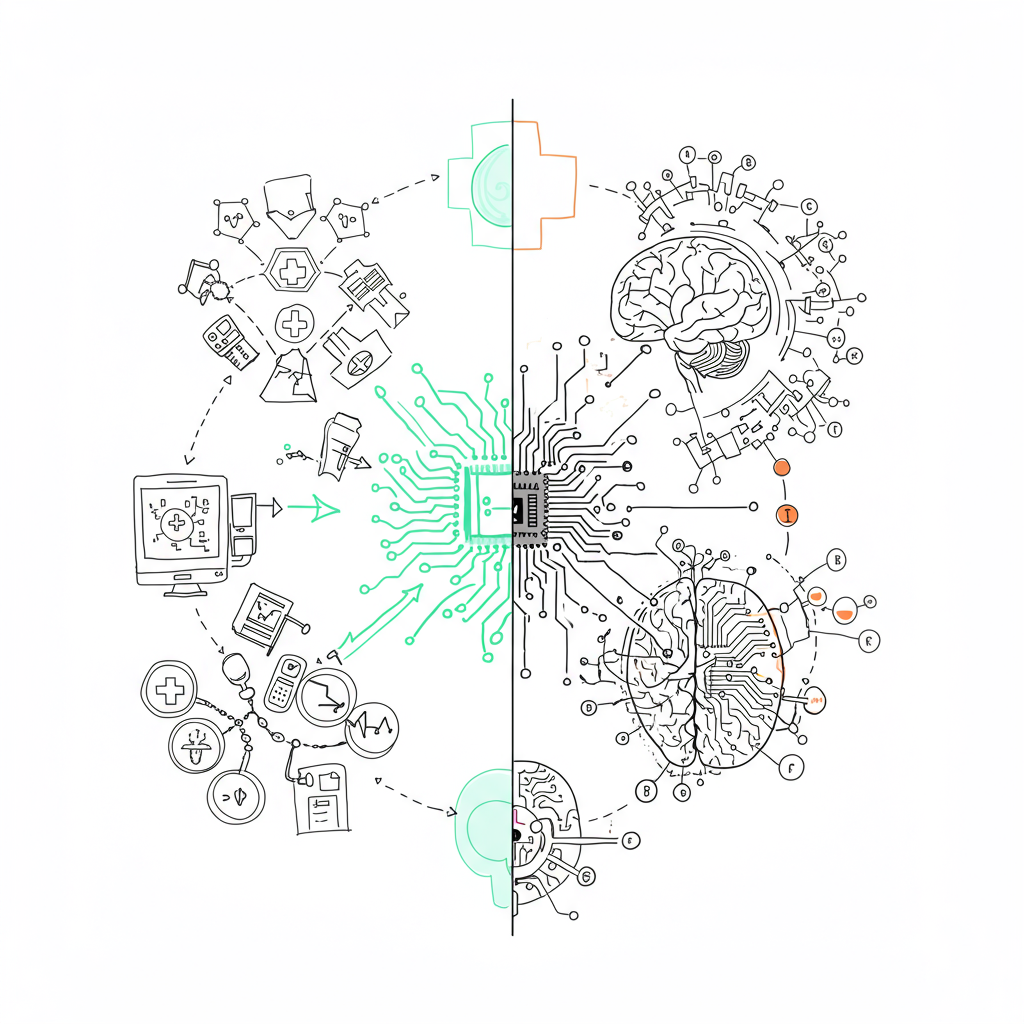Harness AI in Tech Consulting for Business Growth
Discover how AI in tech consulting can transform your business. Explore strategies and real-world examples to drive success today.

Welcome to the new era of technology consulting. It’s an era where artificial intelligence isn't some far-off concept anymore—it's the very engine driving business strategy today. AI is fundamentally changing the game for tech consultants, blending human expertise with data-driven precision to crack tough problems and discover opportunities we couldn't see before.
The New Reality of AI in Tech Consulting
Think of AI's arrival in the consulting world like the invention of the compass for ancient navigators. It didn't just make the journey a bit better; it completely redefined what was possible, opening up entirely new territories for exploration and value. That's what we're seeing now. AI in tech consulting has grown from a niche tool into the heart of modern problem-solving and strategic planning.
This profound shift means both businesses and consultants need to start seeing AI as a strategic partner, not just another piece of software. It’s about building a genuine collaboration where human creativity is magnified by machine intelligence. We call this approach AI co creation, and it's the key to forging a real, lasting competitive advantage.
A New Strategic Imperative
Let's be blunt: organisations that don't weave AI into their strategic thinking will be left in the dust by those that do. The conversation is no longer about "if" we should adopt AI, but "how" we can implement it effectively. Strong AI strategy consulting today isn’t just about deploying technology; it’s about embedding intelligent systems deep into the fabric of a business to deliver real, measurable results.
The economic force behind this change is impossible to ignore. In Germany alone, the artificial intelligence market is on track to hit nearly 10 billion US dollars by 2025, fuelled by a massive wave of digital transformation. You can dig deeper into these trends with this comprehensive analysis from Statista. This incredible growth signals a clear and rising demand for AI-driven solutions that make operations smoother and customer experiences better, cementing its strategic importance.
AI is the catalyst that transforms data from a passive asset into an active, strategic resource. It empowers consultants to move from reactive problem-solving to proactive, predictive guidance that anticipates market shifts and customer needs before they arise.
So, how do you get there? Success demands a structured plan. It all starts with building a solid AI strategy framework that connects the technology directly to your business goals. Next, a thorough AI requirements analysis makes sure you’re aiming at the right problems with the right solutions.
Tools like our AI Strategy consulting tool are built to guide this process, helping businesses pinpoint the most valuable opportunities. The practical applications are vast, as we'll see in various real-world use cases. Navigating this journey is complex, which is why working with our expert team can be the deciding factor in a successful AI integration.
How AI Integration Drives Strategic Wins

When you bring AI into tech consulting, it's about much more than just making things run a bit faster. It's a fundamental shift that rewires how businesses compete and find new paths to growth. We're not just doing the old tasks more efficiently; we're unlocking completely new ways to solve problems and deliver value.
Think of it this way: it’s the difference between giving an accountant a better calculator and giving them a supercomputer to model the entire economy. That’s the leap we’re talking about.
At its heart, AI in tech consulting isn't about replacing people. It's about giving them superpowers. Imagine every consultant having a dedicated team of data scientists on call, 24/7, tirelessly digging through information. This frees up the human experts to do what they do best: think strategically, build relationships, and solve complex problems creatively. Those are the things where human experience will always be king.
From Reactive Fixes to Proactive Strategy
One of the biggest game-changers AI brings to the table is the ability to move from putting out fires to preventing them in the first place. Traditionally, a lot of consulting work has been about fixing issues after they’ve already caused damage. But with AI-powered predictive analytics, consultants can spot warning signs—from a potential supply chain breakdown to a rise in customer churn—long before they hit the bottom line.
This completely flips the script on the client relationship. The conversation shifts from "How do we fix this?" to "How do we build a business that's ready for whatever comes next?" This forward-looking approach is a core part of any modern AI strategy, focusing on building resilience and foresight.
By sifting through historical and real-time data, AI models can pick up on faint signals that point to future events. This lets consultants offer advice that isn't just insightful, but genuinely predictive, giving their clients a real advantage.
Uncovering Hidden Opportunities in Data
Every company is sitting on a mountain of data, but most of it is just gathering dust. AI-driven analysis changes that by automatically digging through this data to find buried treasure. It can spot connections that aren't obvious, find new ways to group customers, or highlight operational kinks that are impossible for a person to see.
Here are a few ways this plays out in the real world:
- Hyper-Personalisation at Scale: AI algorithms can track individual customer actions to offer truly personalised recommendations or marketing. It's a level of customisation that's simply impossible to do by hand when you have thousands or millions of customers.
- Optimised Operations: Machine learning models can analyse everything from factory floor data to logistics networks. They might suggest tweaks that cut waste and boost production or find cheaper, faster shipping routes.
- New Revenue Streams: By analysing market trends and what customers are doing, AI can help spot gaps in the market. This can lead to ideas for brand-new products or services, opening up entirely new lines of business.
Powering Collaborative Innovation
The future of consulting isn't human vs. machine; it's a partnership between expert consultants and intelligent systems. In this model, consultants use AI tools as a starting point—to generate ideas, run simulations, and get data-backed recommendations.
The consultant then steps in, using their years of industry experience and gut instinct to shape those outputs. They ensure the final strategy is not only smart but also practical, ethical, and perfectly aligned with what the client actually needs. This blend of machine-scale analysis and human wisdom delivers stronger, more reliable results, turning ambitious plans into real-world business value.
Understanding the AI Adoption Landscape in Germany

When it comes to adopting AI, not all businesses are on the same page. In Germany, the picture is particularly complex. If you look closely, you’ll see a real split in how quickly different industries and company sizes are moving, which creates both serious gaps and incredible opportunities for smart tech consulting.
This patchwork of progress is exactly why a one-size-fits-all approach to AI in tech consulting just doesn’t work. The hurdles a major automotive firm faces are worlds apart from those of a mid-sized utility company. As we explored in our AI adoption guide, getting to grips with these nuances is the first real step towards building strategies that actually deliver. A generic blueprint won't cut it when you’re dealing with the unique pain points and business realities of each sector.
The Great Divide in German Industry
Certain German sectors are setting a blistering pace. It's no surprise that the automotive, aerospace, and defence industries—long celebrated for their engineering muscle—are leading the pack. They are weaving AI into their operations to fine-tune production, speed up innovation, and hold onto their competitive advantage on the world stage.
But other core industries are falling behind. Telecommunications and utilities, the very foundations of the country's infrastructure, are showing much lower levels of AI integration. This is a risky situation. Lagging adoption here doesn’t just threaten their own competitiveness; it could affect Germany's broader economic strength and technological independence. The only way to close this gap is by showing them clear, achievable value.
Recent research points to a telling difference based on company size. Almost 48% of Europe's largest firms have scaled at least one generative AI project, a figure that dwarfs the 31% adoption rate among smaller businesses. This is a real worry for Germany, where the Mittelstand (SMEs) are the lifeblood of the economy. You can read the full report on accelerating AI adoption in Europe.
The Mittelstand Challenge and Opportunity
Germany's famous Mittelstand—its small and medium-sized enterprises—are up against a specific set of challenges. They are nimble and often highly innovative, but they typically don't have the deep pockets, massive datasets, or specialised talent that larger corporations can access. This is where a focused AI strategy consulting engagement becomes absolutely essential.
The aim isn't for them to copy the AI roadmaps of industrial giants. Instead, it’s about finding high-impact, realistic applications that fit their unique business models. For an SME, a win could be:
- Automating routine admin work to give valuable employees their time back.
- Improving customer support with smart chatbots to answer common questions.
- Getting inventory right with forecasting tools that predict customer demand.
These kinds of targeted projects can offer big returns without needing huge initial investments. It all starts with a sharp AI requirements analysis to identify which problems are most worth solving. By aiming for practical victories, the Mittelstand can build momentum and confidence, proving the power of AI one step at a time and ensuring that every business, big or small, can carve out its own success.
Your Practical Roadmap for AI Implementation
Bringing an AI idea to life can feel like a huge mountain to climb. It’s easy to get lost in the technical details, but with a clear map, the journey becomes far more manageable—and even exciting. This roadmap is designed to do just that, breaking the process down into practical, achievable stages.
The first, and arguably most important, step is to build a solid foundation. This isn't the time to rush into coding or buying flashy software. It’s about smart, strategic alignment. Think of your AI strategy framework as your North Star; it ensures every single action you take points directly toward a meaningful business outcome. Without it, even the most brilliant technology can end up being a solution looking for a problem.
This initial phase is all about asking the right questions. What specific business challenge are we trying to solve? How will we know if we’ve succeeded? What does a "win" actually look like for us? A thorough AI requirements analysis is non-negotiable here. It provides the clarity needed to sidestep common traps like solving the wrong problem or chasing tech for tech's sake.
Selecting Your Pilot Project
Once you know why you're doing this, it's time to choose what you'll do first. The trick is to select a pilot project that delivers a quick, tangible win. You're looking for something that is both achievable and impactful enough to build momentum and get key stakeholders on board. Don’t try to boil the ocean; focus on a specific use case where AI can make a real, noticeable difference.
A great pilot project usually has a few things in common:
- Clear, Measurable Outcomes: You can easily track success through things like cost savings, hours saved, or improved accuracy.
- Accessible Data: The data you need to fuel the project is available and in reasonably good shape.
- High Business Impact: Fixing this specific issue will create a positive ripple effect, whether in one department or across the whole company.
- Manageable Scope: You can realistically get it done in a reasonable timeframe, often within 3-6 months.
By starting with a well-defined pilot, you create a safe space to learn, tweak your approach, and prove the value of AI in tech consulting without taking on massive risk. If you need help identifying and structuring these initial projects, a guided session like our AI strategy workshop can offer incredible clarity.
This infographic lays out the core stages of a typical AI project, showing how performance improves at each step.

As the graphic shows, gains in efficiency and accuracy stack up throughout the process, leading to a reliable and powerful solution.
From Model to Reality
With a pilot project chosen, the real technical work can begin. This part of the journey is a methodical process, moving from raw data to a working model while constantly checking back against that original business goal. This isn't just a task for data scientists; it demands close collaboration between your business, IT, and operations teams.
Before diving into the steps, it’s helpful to visualise the entire implementation lifecycle. The journey from a small-scale pilot to a fully integrated, enterprise-wide solution happens in distinct stages.
AI Implementation Stages From Pilot to Scale
This table breaks down the AI implementation lifecycle, outlining the key activities and objectives for each phase. It's a guide for tech consultants and their clients to navigate the path from a great idea to a scalable solution.
| Phase | Key Activities | Primary Objective |
|---|---|---|
| 1. Pilot | Define a narrow use case, gather initial data, build a proof-of-concept (PoC) model, test in a controlled environment. | Prove the technical feasibility and potential business value of the AI solution on a small scale. |
| 2. Validation | Refine the model with more data, conduct user acceptance testing (UAT), measure initial ROI and performance metrics. | Validate that the model works as expected in a real-world setting and meets user needs. |
| 3. Integration | Integrate the AI model into existing business systems and workflows, establish MLOps for monitoring and maintenance. | Seamlessly embed the AI into day-to-day operations to start delivering value. |
| 4. Scale | Identify new use cases, expand the solution across other departments or regions, continuously retrain and improve the model. | Maximise the return on investment by applying the proven solution more broadly across the organisation. |
Each phase builds on the last, ensuring a controlled, strategic rollout that minimises risk and maximises impact.
With that framework in mind, the technical development of your pilot involves several key steps:
- Data Preparation and Cleansing: This is where the magic really starts, and it's often the most time-consuming part. It involves gathering, cleaning, and structuring data so that an AI model can actually learn from it. Garbage in, garbage out.
- Model Selection and Training: Based on the problem you're solving, the team chooses the right kind of AI algorithm. They then train it on the clean data, constantly tweaking and refining it to get the best possible performance.
- Ethical Design and Bias Mitigation: This is critical. Throughout the development process, you have to actively look for and correct any biases hiding in your data or the model itself. This ensures your outcomes are fair, ethical, and trustworthy.
- Integration and Testing: Finally, the trained model is plugged into existing workflows. It’s then put through its paces with rigorous testing using real-world use cases to make absolutely sure it performs as expected before you even think about a full-scale rollout.
Sidestepping the Pitfalls on Your AI Journey
Let's be realistic: any major AI initiative is going to hit a few bumps. While the upside is huge, the path is littered with common traps that can easily derail even the most well-intentioned projects. When you're applying AI in tech consulting, success often comes down to seeing these hurdles in advance and having a smart plan to navigate them.
So many companies stumble right at the start because their goals are just too vague. If you can't clearly state the business problem you're trying to fix, your AI project is just a ship without a rudder. It becomes a fascinating tech experiment instead of a strategic investment, and those almost always end in disappointment.
Then there's the data problem. This one is a classic. AI models are only as good as the data you feed them. If your data is a mess—incomplete, biased, or just plain wrong—your model’s outputs will be useless. The old "garbage in, garbage out" saying is a painful truth here, and it means putting in the hard work of cleaning and preparing your data before you do anything else.
Deeper Challenges: Systems and People
Beyond the purely technical issues, you'll often run into resistance from the organisation itself—both in its systems and its culture. For German companies, in particular, a major headache is the sheer complexity and cost of taking a promising pilot project and scaling it up across the business. This is made even tougher by gaps in funding and a real shortage of skilled AI specialists.
Germany's own High-Tech Strategy 2025 points directly at these problems. It highlights the national ambition to lead in AI but also candidly admits the barriers we face. The strategy names data limitations, the high cost of scaling, and the urgent need for talent as the biggest roadblocks. This national focus on responsible, human-centric AI also brings ethical questions right to the forefront. You can dive deeper into the strategic analysis of these challenges here.
A successful AI transformation is as much about people as it is about technology. Overlooking the human element—by failing to build the right skills or address cultural resistance to change—is one of the fastest ways to ensure a project fails.
To get around these issues, you have to build a culture that's open to trying new things and learning as you go. This is where a dedicated approach to AI co creation can be a game-changer, getting your tech and business experts in the same room to solve problems together.
Smart Moves to Stay on Track
For every potential pitfall, there's a proactive way to handle it. With solid AI strategy consulting as your guide, you can turn these challenges into chances to build a stronger, more resilient programme.
Here are a few key strategies our expert team uses to keep projects moving forward:
- Start with a Watertight Business Case: Before anyone writes a single line of code, do a thorough AI requirements analysis. Pinpoint the exact problem, set clear KPIs, and get every stakeholder to agree on what success actually looks like.
- Make Data Governance a Priority: Start treating your data like the critical asset it is. Invest in data quality and proper governance from the very beginning. This means making sure your data is clean, easy to access, and truly ready for AI.
- Design for Ethics and Transparency: Build trust by making your AI systems understandable and focused on the people who use them. Put "human-in-the-loop" checks in place for important decisions and regularly check your algorithms for bias. This isn't a final step; it's a core part of the design process.
- Grow Your Talent from Within: Don't just look outside for help. Tackle the skills gap by investing in training for your current team. Create a learning culture where your people feel empowered to work with new AI tools, not threatened by them.
By facing these challenges head-on with a clear plan, your organisation can avoid the common traps. You can make sure your AI initiatives deliver real, measurable value and turn ambitious goals into bottom-line results.
Measuring AI Success and Proving Business Value

So, you’ve invested in AI. The big question from everyone, especially the C-suite, is always the same: "Is it actually paying off?" Answering this is probably the most critical part of any AI in tech consulting project.
It’s easy for tech teams to get bogged down in technical wins, like model accuracy or processing speeds. While those are important for development, they mean very little to stakeholders. To get real, lasting buy-in, you have to connect the dots between the AI’s performance and tangible business results.
This means shifting the conversation away from the lab and onto the balance sheet. You need a way to show how AI is actually moving the needle on what matters to the business. That’s where a balanced scorecard comes in, supported by Key Performance Indicators (KPIs) that everyone from the tech team to the board can understand.
Doing this turns AI from a mysterious cost centre into a clear engine for growth.
Building Your AI Value Scorecard
A great value scorecard doesn't just look at one part of the business. It gives you a panoramic view of AI's impact by tracking progress across three distinct, yet interconnected, areas. This structure helps you tell the full story of your return on investment.
Any solid AI strategy framework should bake these measurement categories in right from the start.
- Operational Efficiency: This is usually the most straightforward area to measure. Think direct cost savings and streamlined internal processes.
- Customer Experience: This is all about how AI is making your customers' lives better, which in turn fuels loyalty and long-term revenue.
- Strategic Growth: This is the forward-looking piece. It tracks how AI is helping you enter new markets, launch innovative products, or simply outmanoeuvre the competition.
By tracking metrics across these three pillars, you build a rock-solid case that justifies not just what you’ve already spent, but what you plan to invest in the future.
Defining Your Key Metrics
Alright, let's get down to brass tacks. What do these metrics actually look like? The golden rule is to pick KPIs that are directly tied to your AI project. If your goals are fuzzy, your results will be too.
An effective AI initiative is one where success is not just felt but measured. By tying every project to clear business metrics, you build a powerful feedback loop that continuously refines your strategy and demonstrates undeniable value.
Here are some practical examples you can adapt for each category:
Operational Efficiency Metrics
- Process Automation Rate: What percentage of a task is now handled entirely by AI? For example, are 90% of initial support tickets now resolved by a chatbot?
- Cost Reduction: How much money have you saved on manual work or resources?
- Time to Completion: How much faster is a business process? Has invoice processing time, for instance, been slashed by 75%?
Customer Experience Metrics
- Customer Satisfaction (CSAT) Score: Have satisfaction scores improved for interactions where AI was involved?
- Net Promoter Score (NPS): Are customers more likely to recommend you to a friend since the AI was introduced?
- Customer Churn Rate: Are fewer customers leaving you? A drop in the churn rate is a powerful indicator of success.
Strategic Growth Metrics
- New Revenue Streams: Did the AI project help you launch a new product or service that’s now generating income?
- Lead Conversion Rate: Are your sales teams closing more deals because of AI-powered insights or lead scoring?
- Market Share Growth: Can you draw a clear line between your AI deployment and an increase in your slice of the market?
This kind of structured approach, often guided by experienced AI strategy consulting, gives you the hard evidence you need to prove the business value of your investment. It shows that AI isn’t just a fancy piece of tech; it’s a fundamental driver of business success. To continuously fine-tune these metrics and your strategy, connect with our expert team.
Your Questions on AI in Consulting Answered
Diving into the world of AI in tech consulting naturally brings up a lot of questions. We get it. Here, we've gathered some of the most common queries we hear from leaders just like you, with straightforward answers to help you navigate your next steps with confidence.
How Do We Start with AI If We Have Limited Data?
This is probably the number one question we're asked. Many businesses think they need a mountain of perfectly curated data to even think about AI, but that’s a myth. It’s actually much smarter to start small.
The trick is to find a single, high-impact business problem that a targeted AI solution can solve. You can get going with what's often called "small data" projects or even use powerful, pre-trained AI models from cloud providers that don't need much of your own data. An AI readiness assessment is a brilliant first step. A focused engagement will help you find those quick wins and map out a practical roadmap that builds momentum without breaking the bank.
What Is the Difference Between AI Strategy and IT Strategy?
It’s easy to see why these get mixed up, but they have fundamentally different goals. Think of your traditional IT strategy as the blueprint for your digital infrastructure—the hardware, software, and networks that keep your daily operations running smoothly. Its main job is to keep the digital lights on, securely and efficiently.
An AI strategy, on the other hand, is all about creating new value. It focuses on using data and intelligent algorithms to reinvent how you work, make smarter decisions, and uncover new revenue streams. It’s less about managing technology and more about embedding intelligence directly into your business. You could say an AI strategy is your core business strategy, just supercharged by technology.
How Can We Ensure Our Use of AI Is Ethical and Avoids Bias?
Making sure your AI is ethical isn't something you can bolt on at the end; it has to be part of the design from day one. This starts with creating a solid governance model built around fairness, accountability, and transparency. A key part of this is having "human-in-the-loop" oversight for any critical decisions, which means a person always has the final say and can override an AI's suggestion.
True ethical AI isn't just about ticking compliance boxes; it's about building genuine trust. When your team and your customers understand how AI works and see that it operates fairly, they're far more likely to get on board.
It's also absolutely vital to train your models on diverse, representative data and to regularly audit your algorithms to spot and fix any bias that creeps in. Being open with everyone—employees and customers alike—about how you're using AI is the foundation of that trust.
For more in-depth answers, feel free to explore our full AI consulting FAQ page. Ultimately, working with our expert team that champions responsible AI gives you the practical guidance needed to build systems that are not only powerful but also trustworthy.



